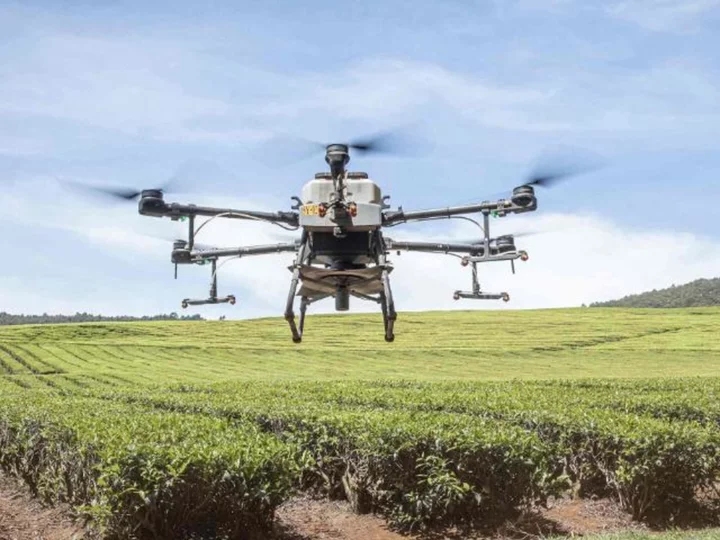When it comes to feeding the planet, we face some monumental challenges.
The global population has increased from 7 billion to 8 billion in the past 12 years, and the UN projects it will reach around 10.4 billion people in the 2080s. That's a lot of extra mouths to feed.
At the same time, the climate crisis means food will become more scarce and more expensive, according to United Nation's climate change panel, while some crops will lose their nutritional value.
Rising to the challenge may take a new agricultural revolution. CNN asked three experts to outline the innovations that can help increase food production without harming the planet.
Plant-based coatings
An astounding 40% of the food grown globally is never eaten, according to WWF. Some is lost during and after harvest, some is lost in the supply chain, and some is wasted when it goes bad on shop shelves or in our homes.
One way to extend the shelf-life of produce is to cover it in an edible plant-based coating, says Richard Munson, author of "Tech to Table: 25 Innovators Reimagining Food."
Munson gives the example of US company Apeel, which he says has created "tasteless, odorless, invisible, and edible coatings -- consisting of fatty acids and other organic compounds extracted from the peels and pulp of produce -- that act as a physical barrier to keep water in and oxygen out."
He says Apeel's coatings can double the shelf-life of avocados, oranges, and other produce.
Researchers in India have also developed edible coatings they say can keep food fresh for longer.
Climate-resilient crops
For many parts of the world, climate change means water is becoming increasingly scarce, and that presents a huge problem for farmers in regions such as the Middle East, which is reliant on desalinated sea water in many places.
Globally, more than 1 billion hectares (2.5 billion acres) of land -- an area larger than China -- -- are already degraded by salinity, according to Dr. Tarifa Alzaabi, director general of the International Center for Biosaline Agriculture (ICBA), a not-for-profit research organization based in Dubai.
One solution is to grow crops that thrive in salty soil. She says ICBA has identified a number of salt-tolerant varieties of date palm, and is successfully cultivating Salicornia, an edible plant found in many parts of the world. Alzaabi describes it as a "desert superhero" for its ability to grow in the brine that's created as a byproduct of the water desalination process.
She adds that ICBA has also tested technologies such as hydrogels (gels that retain water) and sub-surface irrigation systems, and found they can significantly cut farmers' water use.
Precision farming
Around the world, food is grown on land of all sizes and all types, but that diversity means farmers often fail to take into account landscape complexity and soil variability, according to Chandra A. Madramootoo, a professor of Bioresource Engineering at McGill University, in Montreal, Canada.
He says that one solution is precision farming, an approach that "enables the selection of crops, and chemical and water applications within spatially similar land and soil zones."
This can be done through digital mapping, using technologies such as drones and sensors to distinguish the type and characteristics of soil. Geospatial modeling (using statistical models of soil characteristics and topography) can be used to group together areas of landscape that have similar properties.
Together, this can help "sequester more carbon in agricultural ecosystems, conserve water and reduce chemical contamination in complex farming landscapes," says Madramootoo.
Alzaabi says ICBA has been using drones to collect data on its date palm plantation, and has adopted precision agriculture techniques including sensors and smart lysimeters (devices that measure moisture loss) to optimize fertilizer application and the use of irrigation water.
Insect protein
A traditional source of protein in parts of Africa, Asia and South America, growing insects for food is becoming more mainstream elsewhere. In 2020, Nestlé launched Purina Beyond Nature's Protein pet food, which includes insect protein, millet and fava beans. In Singapore, Insectta grows black soldier fly maggots for use in animal feed. The maggots are fed food waste, such as the byproducts of soybean factories and breweries.
"Poultry and fish farms have long relied on chemicals ... and irrigation to grow corn and soybeans," says Munson. "Insects such as mealworm beetles offer alternatives. They take up little space, live happily when jammed together, survive without light, breed throughout the year, emit few pollutants or greenhouse gases, and require little feed."
Taking a "wholescapes" approach
"Food production is being undertaken at the expense of biodiversity losses," says Madramootoo. One reason, he says, is a failure to take into account the "multiplicity of adjoining ecosystems."
He calls for a "wholescapes approach," producing food sustainably across all ecosystems -- coastal, marine and terrestrial, including forests, agricultural land and urban areas.
"The benefits include production of protein from marine resources, integration of wetlands with aquaculture systems and fish farming, and the use of forestry systems to also produce food," says Madramootoo, adding that agroforestry and silviculture (the management of forests) can benefit peoples' livelihoods, increase food production, aid conservation and increase carbon stocks.
Urban farming
Madramootoo says that a wholescapes approach can also be applied to food production in urban and peri-urban areas -- the spaces immediately surrounding a city.
"Trees in peri-urban and urban areas can provide food, provide shade, have a cooling effect and sequester carbon," he says. "Rooftops ... can be used to grow food. We can make use of gray water and waste energy from homes to grow food in small plots, shade houses or covered tunnels where frost is likely to occur.
"In congested peri-urban areas, we can use vertical farms in warehouses or abandoned buildings, for example, to produce food. This cuts down the need for water and high-cost chemical inputs and reduces the waste stream."
Vertical farms of this kind have become more widespread in recent years. Using LEDs to grow crops indoors, without soil, these farms are heavily automated, with nutrient-rich water delivered straight to a plant's roots.
"They use no pesticides and cut water use by 95%," says Munson of vertical farms. "They produce 100 times the output of an equivalent-sized plot of horizontal land.
"With a growing season that never ends, they allow the quick delivery of fresh and organic greens to local restaurants and supermarkets throughout the year; and they offer good-paying jobs in formerly abandoned spaces within neglected neighborhoods."









